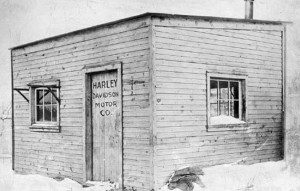
‘Where to begin?’
William S. Harley and Arthur Davidson asked themselves that question in 1901.
One answer was the blueprint of an engine that would fit into a bicycle frame.
Another was the 10′ X 15′ backyard shed on your left.
It became the Harley-Davidson factory in 1903, complete with hand lettering on the door.
Lettering that reflects the essence of the enterprise, not the trimmings.
Maybe that’s why a marketing director we know has this photo framed on his office wall.
It helps him think in a ‘start up’ way, he says.
It prompts curiosity, it spurs ‘what if’ questions and it motivates him to do anything it takes to succeed.
So it’s enviable that our fifty-something marketer thinks like a twenty-something in a start-up, right?
Not so right.
As our marketer says, ‘start up thinking isn’t always shared by everyone in a Fortune 500 company’.
It can brand you as a rule breaker. A contrarian. An outsider.
Especially if your ideas go against the established strategy of the day.
After all, when money is rolling in, why tamper with your revenue stream? Why change?
Shareholders will be the first to echo that.
So how do you improve on improvement?
How do you get different thinking to be taken seriously?
How do you change so you can avoid difficulties like the ones Kodak suffered?
On the positive side, how do you cash in on opportunities nobody else sees, like Reid Hoffman, founder of LinkedIn.
All tough questions.
Harley-Davidson was forced to grapple with each one, and more.
For decades their engineering was unchanged; H-D wasn’t famous for innovation.
Few thought of making improvements to bikes that were bringing in revenue.
But that wasn’t to last.
H-D became vulnerable to the massive importing of Japanese bikes.
The company almost went belly up.
There were ownership changes and massive restructurings.
They suffered strikes and losing younger customers to the competition.
As you’d expect, stock prices fell.
Eventually H-D embraced the idea of change.
They went beyond the established strategies with new designs.
The company came back as brand leaders in America for heavyweight motorcycles.
The new ‘Revolution X’ platform, lightweight bikes aimed at Millennials, is in place to broaden the appeal of the brand.
And maybe with the 10 X 15 factory in mind, H-D thinking has become more like start-up thinking.
Evidence of that is Project LiveWire — the design and manufacture of electric motorcycles. http://bit.ly/1M5iEf3
There’s a radical change for you.
A turbine sound isn’t exactly in character with the traditional exhaust note of a Harley … http://bit.ly/182aveh.
But when it comes to the future, an electric whine on the highway could be an answer to one vital question.
‘Where to begin?’
Share with us. Leave your comment below. Thanks for reading Whybetonto.com. Regards, Steve Ulin LinkedIn: http://linkd.in/1Bey3Jl